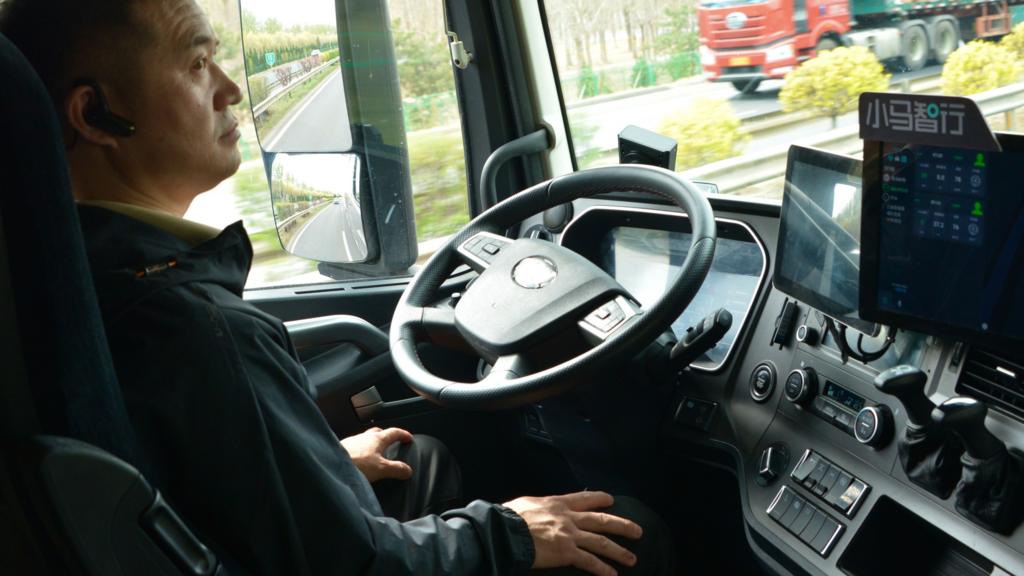Autonomous trucks are steadily making their presence known on the highway between Beijing and Tianjin port. These large vehicles, capable of self-navigation, are currently piloted by safety drivers, a requirement of Chinese regulations. However, industry experts predict the elimination of this role in the near future.
For 32-year-old safety driver Huo Kangtian, relinquishing control to the vehicle’s autonomous system is a mix of awe and apprehension. Initially, he maintains full control, before activating the self-driving function with a few button presses, allowing the truck to navigate at speed along public roads.
“Initially, I was apprehensive,” admits Mr. Huo. “But extensive observation and testing have convinced me of their safety and capability.”
The autonomous system adeptly handles highway maneuvers, including navigating toll plazas, before Mr. Huo resumes control. His role, he explains, is as a final safety net, taking over immediately in emergencies.
Mr. Huo highlights the benefits of autonomous driving, such as stress reduction and freeing up the driver for other tasks, thereby enhancing job satisfaction rather than inducing boredom.
When questioned about potential job displacement, his response is diplomatic, reflecting the uncertainty surrounding the issue.
Pony AI’s fleet of autonomous trucks, currently operating on test routes, represents a significant step, according to Vice President Li Hengyu. He emphasizes the potential for significantly improved transportation efficiency through reduced labor costs and enhanced handling of challenging conditions and extended driving hours.
Professor Yang Ruigang of Shanghai Jiaotong University, an expert in autonomous vehicle technology, points to cost savings as the primary driver of investment. The ultimate goal, he explains, is to “reduce driver costs close to zero.”
Despite the potential benefits, significant hurdles remain, not least public perception. A previous accident involving a self-driving passenger vehicle which resulted in fatalities highlighted public safety concerns.
Chim Lee of the Economist Intelligence Unit notes that public acceptance in China is still developing. “Recent accidents involving passenger cars have caused considerable public outcry,” he states, “This will be critical for policy makers and the market.”
Professor Yang agrees that widespread job displacement for truck drivers is unlikely in the immediate future, suggesting that current applications are more likely to be in low-speed, controlled environments like last-mile deliveries.
In Hefei, Anhui Province, hundreds of autonomous delivery vans operate amidst conventional traffic, showcasing a more mature deployment model. Rino.ai, a leading autonomous vehicle company, has found a niche market in delivering parcels from distribution hubs to local stations, where human couriers complete the final delivery.
Gary Huang, Rino.ai’s president, explains that this approach optimizes efficiency, and anticipates rapid adoption in Australia later this year. In China, Rino operates over 500 vans across 50 cities, with Hefei serving as a leading example of successful integration.
Hefei’s success, according to Huang, is attributed to a collaborative approach involving government support, local experimentation, regulatory refinement, and widespread implementation. These vans navigate city streets, demonstrating capabilities comparable to human drivers.
Courier companies report significant improvements in delivery speed and cost efficiency, with Rino’s Anhui regional director, Zhang Qichen, predicting widespread autonomous heavy-haul trucking within five years.
Professor Yang shares this optimistic outlook, emphasizing the likelihood of autonomous trucks operating on unrestricted highways within five years.
Experts believe immediate applications for autonomous heavy-haul trucking will focus on remote or challenging environments with largely predictable routes. However, significant technical challenges remain, including the need for enhanced sensing capabilities, robust infrastructure, and addressing the potential for breakdowns in adverse conditions.
The technology remains expensive, with current autonomous trucks largely based on retrofitted models. While China aims to lead in autonomous vehicle technology, careful consideration of public perception and safety is crucial.
Chim Lee stresses that public acceptance requires demonstrating tangible benefits, while Professor Yang notes that public tolerance for errors in autonomous systems is far lower than that for human drivers, emphasizing the need for exceptional reliability.

